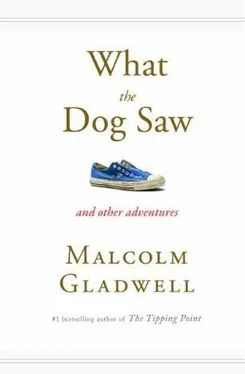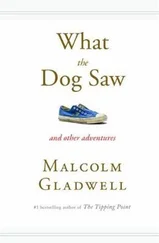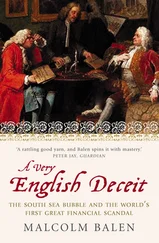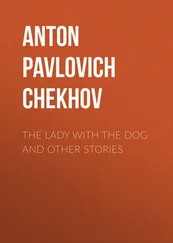The ketchup tasting took place over four hours, on two consecutive mornings. Six tasters sat around a large, round table with a lazy Susan in the middle. In front of each panelist were two one-ounce cups, one filled with Heinz ketchup and one filled with World’s Best. They would work along fourteen dimensions of flavor and texture, in accordance with the standard fifteen-point scale used by the food world. The flavor components would be divided two ways: elements picked up by the tongue and elements picked up by the nose. A very ripe peach, for example, tastes sweet but it also smells sweet—which is a very different aspect of sweetness. Vinegar has a sour taste but also a pungency, a vapor that rises up the back of the nose and fills the mouth when you breathe out. To aid in the rating process, the tasters surrounded themselves with little bowls of sweet and sour and salty solutions, and portions of Contadina tomato paste, Hunt’s tomato sauce, and Campbell’s tomato juice, all of which represent different concentrations of tomato-ness.
After breaking the ketchup down into its component parts, the testers assessed the critical dimension of “amplitude,” the word sensory experts use to describe flavors that are well blended and balanced, that “bloom” in the mouth. “The difference between high and low amplitude is the difference between my son and a great pianist playing ‘Ode to Joy’ on the piano,” Chambers says. “They are playing the same notes, but they blend better with the great pianist.” Pepperidge Farm shortbread cookies are considered to have high amplitude. So are Hellmann’s mayonnaise and Sara Lee poundcake. When something is high in amplitude, all its constituent elements converge into a single gestalt. You can’t isolate the elements of an iconic, high-amplitude flavor like Coca-Cola or Pepsi. But you can with one of those private-label colas that you get in the supermarket. “The thing about Coke and Pepsi is that they are absolutely gorgeous,” Judy Heylmun, a vice president of Sensory Spectrum, Inc., in Chatham, New Jersey, says. “They have beautiful notes—all flavors are in balance. It’s very hard to do that well. Usually, when you taste a store cola it’s”—and here she made a series of pik! pik! pik! sounds—“all the notes are kind of spiky, and usually the citrus is the first thing to spike out. And then the cinnamon. Citrus and brown spice notes are top notes and very volatile, as opposed to vanilla, which is very dark and deep. A really cheap store brand will have a big, fat cinnamon note sitting on top of everything.”
Some of the cheaper ketchups are the same way. Ketchup aficionados say that there’s a disquieting unevenness to the tomato notes in Del Monte ketchup: tomatoes vary, in acidity and sweetness and the ratio of solids to liquid, according to the seed variety used, the time of year they are harvested, the soil in which they are grown, and the weather during the growing season. Unless all those variables are tightly controlled, one batch of ketchup can end up too watery and another can be too strong. Or try one of the numerous private-label brands that make up the bottom of the ketchup market and pay attention to the spice mix; you may well find yourself conscious of the clove note or overwhelmed by a hit of garlic. Generic colas and ketchups have what Moskowitz calls a hook—a sensory attribute that you can single out, and ultimately tire of.
The tasting began with a plastic spoon. Upon consideration, it was decided that the analysis would be helped if the ketchups were tasted on French fries, so a batch of fries was cooked up and distributed around the table. Each tester, according to protocol, took the fries one by one, dipped them into the cup—all the way, right to the bottom—bit off the portion covered in ketchup, and then contemplated the evidence of their senses. For Heinz, the critical flavor components—vinegar, salt, tomato ID (overall tomato-ness), sweet, and bitter—were judged to be present in roughly equal concentrations, and those elements, in turn, were judged to be well blended. The World’s Best, though, “had a completely different view, a different profile, from the Heinz,” Chambers said. It had a much stronger hit of sweet aromatics—4.0 to 2.5—and outstripped Heinz on tomato ID by a resounding 9 to 5.5. But there was less salt, and no discernible vinegar. “The other comment from the panel was that these elements were really not blended at all,” Chambers went on. “The World’s Best product had really low amplitude.” According to Joyce Buchholz, one of the panelists, when the group judged aftertaste, “it seemed like a certain flavor would hang over longer in the case of World’s Best—that cooked-tomatoey flavor.”
But what was Jim Wigon to do? To compete against Heinz, he had to try something dramatic, like substituting maple syrup for corn syrup, ramping up the tomato solids. That made for an unusual and daring flavor. World’s Best Dill ketchup on fried catfish, for instance, is a marvelous thing. But it also meant that his ketchup wasn’t as sensorily complete as Heinz, and he was paying a heavy price in amplitude. “Our conclusion was mainly this,” Buchholz said. “We felt that World’s Best seemed to be more like a sauce.” She was trying to be helpful.
There is an exception, then, to the Moskowitz rule. Today there are thirty-six varieties of Ragú spaghetti sauce, under six rubrics—Old World Style, Chunky Garden Style, Robusto, Light, Cheese Creations, and Rich & Meaty—which means that there is very nearly an optimal spaghetti sauce for every man, woman, and child in America. Measured against the monotony that confronted Howard Moskowitz twenty years ago, this is progress. Happiness, in one sense, is a function of how closely our world conforms to the infinite variety of human preference. But that makes it easy to forget that sometimes happiness can be found in having what we’ve always had and everyone else is having. “Back in the seventies, someone else—I think it was Ragú—tried to do an ‘Italian’-style ketchup,” Moskowitz said. “They failed miserably.” It was a conundrum: what was true about a yellow condiment that went on hot dogs was not true about a tomato condiment that went on hamburgers, and what was true about tomato sauce when you added visible solids and put it in a jar was somehow not true about tomato sauce when you added vinegar and sugar and put it in a bottle. Moskowitz shrugged. “I guess ketchup is ketchup.”
September 6, 2004
Blowing Up
HOW NASSIM TALEB TURNED THE INEVITABILITY OF DISASTER INTO AN INVESTMENT STRATEGY
One day in 1996, a Wall Street trader named Nassim Nicholas Taleb went to see Victor Niederhoffer. Victor Niederhoffer was one of the most successful money managers in the country. He lived and worked out of a thirteen-acre compound in Fairfield County, Connecticut, and when Taleb drove up that day from his home in Larchmont he had to give his name at the gate, and then make his way down a long, curving driveway. Niederhoffer had a squash court and a tennis court and a swimming pool and a colossal, faux-alpine mansion in which virtually every square inch of space was covered with eighteenth- and nineteenth-century American folk art. In those days, he played tennis regularly with the billionaire financier George Soros. He had just written a best-selling book, The Education of a Speculator, dedicated to his father, Artie Niederhoffer, a police officer from Coney Island. He had a huge and eclectic library and a seemingly insatiable desire for knowledge. When Niederhoffer went to Harvard as an undergraduate, he showed up for the very first squash practice and announced that he would someday be the best in that sport; and, sure enough, he soon beat the legendary Shariff Khan to win the US Open squash championship. That was the kind of man Niederhoffer was. He had heard of Taleb’s growing reputation in the esoteric field of options trading and summoned him to Connecticut. Taleb was in awe.
Читать дальше











